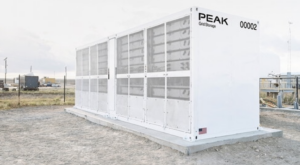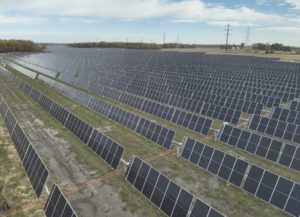Competitive generation giant Constellation has agreed to acquire Calpine Corp. in a $16.4 billion deal that is set to create the largest producer of clean and reliable energy in the U.S. with an asset portfolio of more than 60 GW.
The definitive agreement, announced on Jan. 10, includes a cash and stock transaction valued at an equity purchase price of approximately $16.4 billion. The deal consists of 50 million shares of Constellation stock and $4.5 billion in cash, plus the assumption of $12.7 billion of Calpine’s net debt. “After accounting for cash that is expected to be generated by Calpine between signing and the expected closing date, as well as the value of tax attributes at Calpine, the net purchase price is $26.6 billion, reflecting an attractive acquisition multiple of 7.9x 2026 EV/EBITDA,” Constellation said on Friday.
Calpine’s owners, led by Energy Capital Partners (ECP), will hold equity in the combined company and have agreed to an 18-month lock-up period. The deal is expected to close within 12 months, pending regulatory approvals. The acquisition will require regulatory clearance from the Federal Energy Regulatory Commission, the Public Utility Commission of Texas, and other agencies. Lazard and J.P. Morgan advised Constellation, while Evercore and Morgan Stanley served as advisors to Calpine.
If finalized, the acquisition will mark a historic business combination—one of the largest for the U.S. generation business—merging the largest nuclear fleet in the country with the largest natural gas fleet. It will generate more electricity than any other company in the U.S.
“We’re going to have more than 60 GW of capacity from nuclear, natural gas, geothermal, wind, and solar, an 80% increase to Constellation’s capacity, capability,” said Constellation President and CEO Joe Dominguez during an investor call on Friday. “These plants will produce an industry-leading 308 million MWh of electricity every year.”

Creating a Formidable Nuclear-Gas Powerhouse
The move is bold for Constellation, which has established itself as a major competitive generator committed to decarbonization since its 2022 spinoff from parent Exelon. The independent, publicly traded company today boasts the largest nuclear fleet in the nation, comprising 21 GW from 23 units, which provide baseload zero-emission power. In November 2023, it completed an acquisition of NRG Energy’s 44% ownership in the 2.6-GW South Texas Project Electric Generating Station (STP), a nuclear power plant located in Bay City, Texas, and in September 2024, the company partnered with Microsoft to commit $1.6 billion to restart Unit 1 of the shuttered Three Mile Island plant in Pennsylvania by 2028. Constellation’s massive 32.4-GW fleet also includes 12 GW of natural gas, oil, hydroelectric, wind, and solar assets, which provide baseload, intermediate, and peaking functions.
Beyond generation, the Baltimore–headquartered energy giant has a significant customer-facing business, including an hourly Carbon-Free Energy (CFE) platform, which serves commercial and industrial (C&I) partners, with major customers like Microsoft and Comcast. The platform matches real-time customer demand with carbon-free generation to support their transition to 100% carbon-free power. On Jan. 2, Constellation secured a historic 10-year electricity purchase contract from the U.S. General Services Administration (GSA), partially bundled with CFE. The deal, which Constellation on Friday highlighted as a potential model for states and utilities, will fund license extensions and upgrades at its nuclear plants, increasing output by 135 MW. GSA is set to procure 2.4 million MWh of the new capacity to enable federal agencies to achieve 100% carbon-free electricity by 2030.
Constellation on Friday lauded nuclear’s lucrative financial benefits, noting that it expects to capture significant value through the nuclear production tax credit (PTC), which could add more than $750 million in revenues, even under a 3% inflation scenario. The company also said it is evaluating opportunities to add up to 1 GW of additional nuclear upgrades across its fleet. It also highlighted recent regulatory changes that will allow merchant nuclear plants to participate in hydrogen production.
Calpine Corp., founded in 1984, has transitioned from a small geothermal operator into a major energy provider with a 28-GW footprint in 22 states, Canada, and Mexico. After facing significant financial challenges, the company underwent a major transformation in 2018 to become a privately held entity backed by a select group of investors. Today, Calpine has a diverse fleet of 79 operational power plants, 61 of which are primarily combined cycle gas turbines (a combined capacity of 26 GW and 425 MW of new gas power plants under construction). Calpine, notably, also leads the nation’s generation of geothermal power, with 13 operating plants (a combined capacity of 725 MW) located in Northern California. In addition, it has a 740-MW solar and battery asset fleet, and another 160-MW under construction. Meanwhile, though Calpine is cultivating a growing fleet of carbon capture and sequestration projects, it has “no coal generation or coal liabilities,” Constellation noted.
The combined portfolio of nuclear and gas-generating assets “is best-in-class” and well-suited to the combined company’s approximately 200 million MWh of retail electric load to customers across the country, Dominguez noted on Friday. “Our customer mix will remain 90% commercial and industrial customers. That’s been a long-standing focus because we think those are the customers that we pair up best in the composition of our assets. The platform is going to be able to sell more products to all of these customers, products like our highly successful hourly CFE product,” he added.
While Constellation has been a leader in the nuclear industry with excellent performance numbers, Dominguez said Calpine’s gas assets have also demonstrated high availability and capacity factors. “Like us, Calpine has been developing sustainability for products for their customers, lending natural gas power with renewable power to create a pathway for sustainability that has been a great product,” he said.
The Timing Is Important, Dominguez Says
As Dominguez explained to investors, the combined company’s most prominent opportunity lies in demand growth projections. “We’re going to create this largest, cleanest, reliable generation at a time when these megawatts are being recognized as premium products because they’re needed to meet the growing demand for energy for our customers,” he said. “The fact of the matter is, demand for our products is expected to grow at levels we haven’t seen in a lifetime.”
Demand growth within the Electric Reliability Council of Texas (ERCOT) and PJM Interconnection pose an especially lucrative prospect, he suggested. “Now listen, I get it: We can all raise questions about the ultimate magnitude of these increases. Do we believe all of it’s real? It’s hard to say, really, but let me offer a couple of thoughts here. First, even if only half or a third of this forecasted growth occurs, it’s a very big deal, and the combined company assets will be very well positioned.”

“Second, what’s more compelling to me than the ultimate amount of projected growth—which is, again, something we could always debate—is that we’re seeing year-over-year increases to the annual forecasts. And you see those forecasts in the solid line on this slide. It’s not forecast we’re seeing, we’re seeing a lot of activity on the ground,” said Dominguez.
That growth is being driven by large part by data centers, digitalization, and electrification. “The demand is real, and the demand for reliable power assets that can operate at high capacity factors is growing even more dramatically because of the composition of the demand,” he said. The demand is not just for peaking power, but—especially for data centers—it is for “24/7 energy” resources, he said. “Now, in contrast to the 24/7 demand we’re seeing, the reality is the megawatts that we’re adding to the system, those megawatts that are in the queue are primarily intermittent resources and short duration battery storage. There’s just very limited dispatchable generation planned to be added in PJM, ERCOT, and California.”
Echoing the North American Electric Reliability Corp. (NERC) and several regional transmission organizations (RTOs), Dominguez noted that while renewables are slated to play an “enormous role,” their variability poses reliability implications seasonally and day-to-day. “Independent studies from independent system operators (ISOs) and even some environmental NGOs all agree on the continued need for natural gas-fired generation,” he said. “Reliability is equally important as sustainability, and we just have to solve for both—just don’t have a choice.”

Calpine: A Complementary and Strategic Fit
Dominguez on Friday also highlighted the combined company’s strategic coast-to-coast reach within the continental U.S. “I think what the transaction does is puts us in the customer conversation in every single region of the country that’s competitive, and that’s exciting because what it does is it transitions relationships with customers from transactional to truly strategic, where we can serve in multiple markets and give them multiple options,” he said.
In addition, he noted, it creates substantial market diversification. “It moderates our reliance on PJM and it expands our presence in Texas—the fastest growing power demand market—and in California, where we’ve been growing a customer business for the last couple of decades.” While Constellation has been working to grow its generation business in Texas, “we couldn’t do it fast enough,” he noted. “Through this combination, our owners will have better upside exposure to growth in Texas.”
In a statement on Friday, Andrew Novotny, president and CEO of Calpine, also lauded the companies’ complementary attributes, including shared goals to supercharge investment in emerging technologies, including carbon capture and new nuclear. “This is an incredible opportunity to bring together top-tier generation fleets, leading retail customer businesses, and the best people in our industry to help drive a stronger American economy for a cleaner, healthier, and more sustainable future,” he said. “Together, we will be better positioned to bring accelerated investment in everything from zero-emission nuclear to battery storage that will power our economy in a way that puts people and our environment first.”
—Sonal Patel is a POWER senior editor (@sonalcpatel, @POWERmagazine).










